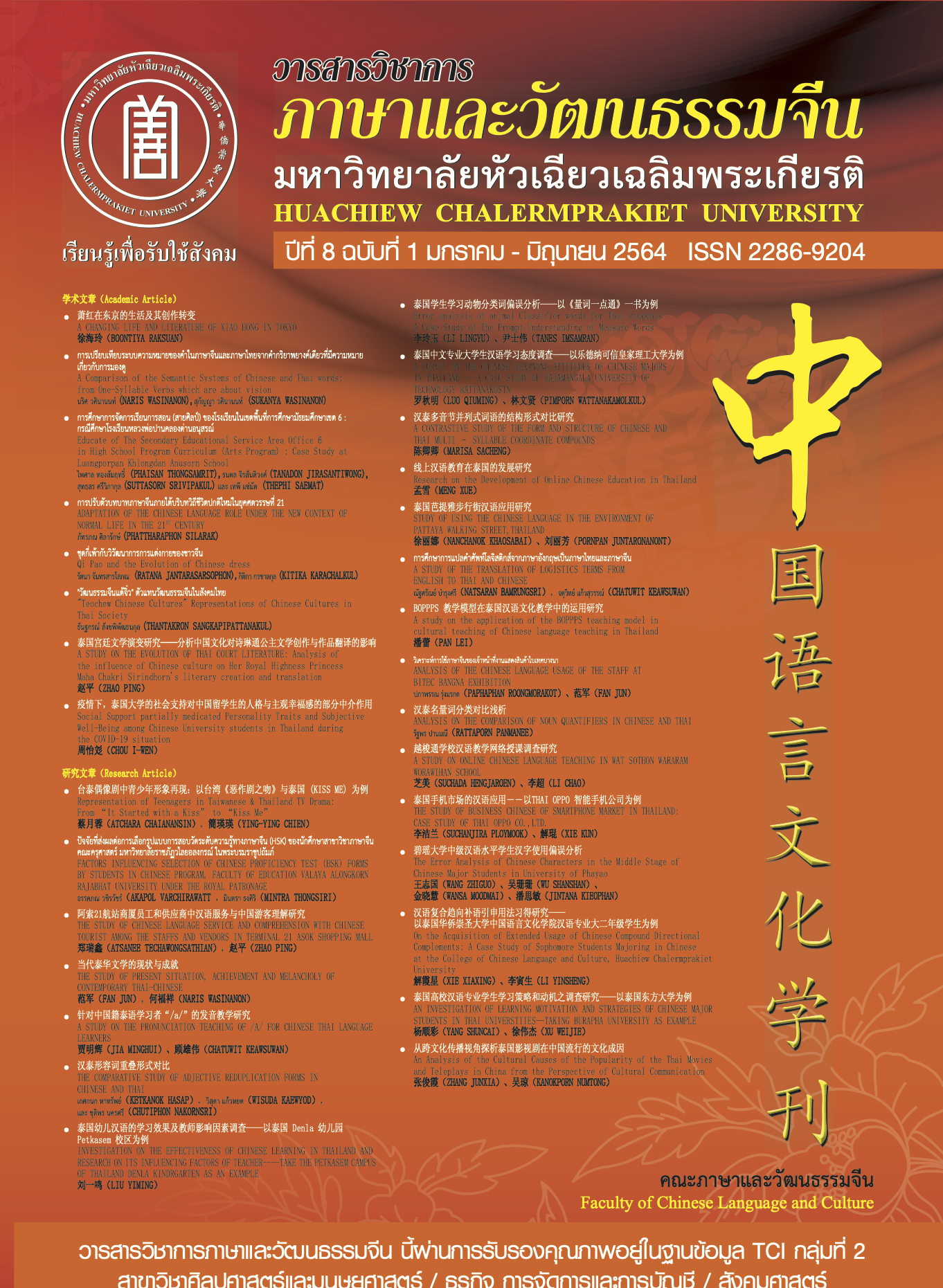A CONTRASTIVE STUDY OF THE FORM AND STRUCTURE OF CHINESE AND THAI MULTI – SYLLABLE COORDINATE COMPOUNDS
Keywords:
Chinese and Thai, multi-syllable, parallel words, structure types, comparative analysisAbstract
Coordinate word formation is an important word formation method in both Chinese and Thai. However, the conceptual categories of coordinate compounds in Chinese and Thai are different. From the perspective of the types of associations between the constituent components, Chinese and Thai coordinate words are composed of two or more morphemes with the same, similar, related or opposite meanings. And there are three types of coordinate compounds, including consonance, divergence and classification. In addition, the conceptual category of Thai coordinated words also includes "phonetic related coordinated compounds", that is, a word composed of two or more syllables that have a harmonious relationship between phonetics and rhyme. The two components of the coordinate words are not semantically related, and the two components mainly have a harmonious relationship in phonetics.
In this paper, we count and investigate the multi-syllable coordinate compounds in the "Chinese Test Dictionary" and "Thai National Corpus Word Frequency Table". It is found that both Chinese and Thai have mainly four syllables, and in Thai were also found singular three-syllable and five-syllable coordinate words. Chinese four-syllable coordinate compounds mainly include three structural types: "Cascade Coordinates (CACB/ACBC)", "Cross Coordinates (A1A2B1B2)" and "Two-word Coordinates ([A1B1][A2B2])", of which "Cross Coordinates" has the highest proportion. Thai four-syllable coordinate compounds mainly include six structural types: "Cascade Coordinates (CACB)", "Phonetic Related Cascade Coordinates (CACB)", "Two-word Coordinates ([A][B])", and "Phonetic Semantically Related Two-word Coordinates ([A1B1][A2B2]), "Two-word Cascade Coordinates ([CA][CB])" and "Purely Phonetic Related Coordinates (ABCD)", among which the “Phonetic Related Cascade Coordinates” has the highest proportion. It can be seen from the number of syllables and structure types that Thai coordinate compounds are more focused on phonological harmony, while the aesthetic interest of "balanced symmetry" of the Chinese plays a certain role in the construction of four-syllable coordinate compounds.
References
丁喜霞. 《中古常用并列双音词的成词和演变研究》[M]. 北京:语文出版社, 2006.
中国社会科学院语言研究所词典编辑室.《现代汉语词典(第七版)》[M]. 北京:商务印书馆,2016.
冯胜利. 论汉语的“韵律词”. [J]. 中国社会科学, 1996, (1).
吕叔湘. 汉英语法比较举例. [J]. 外语教学与研究, 1977, (2).
刘迎迎. 浅析并列式复合词的词义与语素义关系. [J]. 文学教育, 2014, (1).
刘国泰. 古汉语联合式双音词试析. [J]. 江西师范大学学报(哲学社会科学版), 1985, (2).
刘叔新.《汉语描写词汇学》[M]. 北京:商务印书馆, 1990.
刘瑞英. 汉泰构词法对比研究. [D]. 广西民族大学硕士学位论文, 2016.
陈 宏. 现代汉语同义并列复合词词类、词序分析. [J]. 南开语言学刊, 2008, (1).
陈爱文、于平. 并列式双音词的字序. [J]. 中国语文, 2979, (2).
张国宪. 并列式合成词的语义构词原则与中国传统文化. [J]. 汉语学习, 1992, (5).
张 博. 先秦并列式连用词序的制约机制. [J]. 语言研究, 1996, (2).
张 博. 组合同化:词义衍生的一种途径. [J]. 中国语文, 1999, (2).
张 谦. 现代汉语反义语素合成词研究. [D]. 河北大学硕士学位论文, 2006.
邵敬敏主编.《汉语水平考试词典》[M]. 上海:华东师范大学出版社, 2000.
肖晓晖. 对一类并列复合词的意义分析. [J]. 井冈山师范学院学报(哲学社会科学), 2003,(3).
沈家煊. 汉语“大语法”包含韵律. [J]. 世界汉语教学, 2017. (1).
沈家煊. 新说四字格. [J]. 世界汉语教学, 2019, (3).
周 荐. 复合词构成的语素选择. [J]. 中国语言学报, 1995, (7).
周 荐. 《词汇论》[M]. 北京:商务印书馆, 2016.
赵小刚. 先秦汉语并列式结构音节排序的规律、声调搭配的趋势及音节声母的倾向. [J]. 语言研究,2012,(4).
赵凤娇. 汉语二语学习者并列式复合词词义识解研究. [D]. 北京语言大学硕士学位论文, 2017.
段洁琼. 含比喻义双音并列复合词之教学探究. [D]. 西北大学硕士学位论文, 2011.
黄伯荣、廖序东.《现代汉语(上册)》[M]. 北京:高等教育出版社, 2011.
符淮青. 词义和构成词的语素义的关系. [J]. 辞书研究, 1981, (1).
葛怡爽. 汉语并列复合词与英语成对词对比研究. [J]. 现代汉语(语言应用研究), 2017. (1).
橝晶晶. 面向对外汉语教学的现代汉词同义复合词研究. [D]. 黑龙江大学硕士学位论文, 2008.
戴庆厦(2015)汉藏语并列复合词韵律词序的类型学特征——兼论汉藏语语法类型学研究的一些认识问题. [J]. 吉林大学社会科学学报, 2015, (3).
Aunchaleenukul, S. The words system of Thai Language. [M]. Bangkok: Chulalongkorn University, 2003.
Buachu, K. Reconstructed Words: The Study from the Dictionary of Royal Institute of Thailand (1982 Edition). [D]. Pitsanulok: M.A.Dissertation, Naresuan University, 1992.
Chanawong, P. The Principles of Thai Language. Nakhon. [M]. Ratchasrima: Textbook and Document Project of Rajabhat University of Nakhon Ratchasrima, 1995.
Changkwanyuen, W. The Norm of Thai language Vol.2: Word, Word Reconstruction and Word Borrowing. [M]. Bangkok: The Institute of Thai Language, The Committee of Elementary Education of The Ministry of Education, 2010.
Dhanvarjor, R. A Study of Lexical Reduplication in Thai. [D]. Ph.D.Dissertation, Chulalongkorn University, 1991.
Mahatthanasin, D. Structure of the Thai Language. [M]. Chiangmai: Suriwong Book Center, 1973.
Panthumaytha, B. The Characteristic of Thai Language. [M]. Bangkok: Ramkamhaeng University, 1971.
Phraya Anumarnratchathon. Etymology part 2(1 st edition). [M]. Phranakhon: Rungruengtham Press, 1956.
Phraya Ooppakitsilapasarn. The Principles of Thai Language. [M]. Bangkok : Thai Wattanapanit Publications, 1922.
Settawat, R. Synonymous Compounds in the Thai language. [D]. M.A.Dissertation, Chulalongkorn University, 1973.
Downloads
Published
How to Cite
Issue
Section
License
บทความที่ได้รับการตีพิมพ์เป็นลิขสิทธิ์ของวารสารภาษาและวัฒนธรรมจีน มหาวิทยาลัยหัวเฉียวเฉลิมพระเกียรติ
บทความใน “วารสารวิชาการภาษาและวัฒนธรรมจีน” เป็นทรรศนะของผู้เขียนโดยเฉพาะ กองบรรณาธิการไม่มีส่วนในความคิดเห็นในข้อเขียนเหล่านั้น




